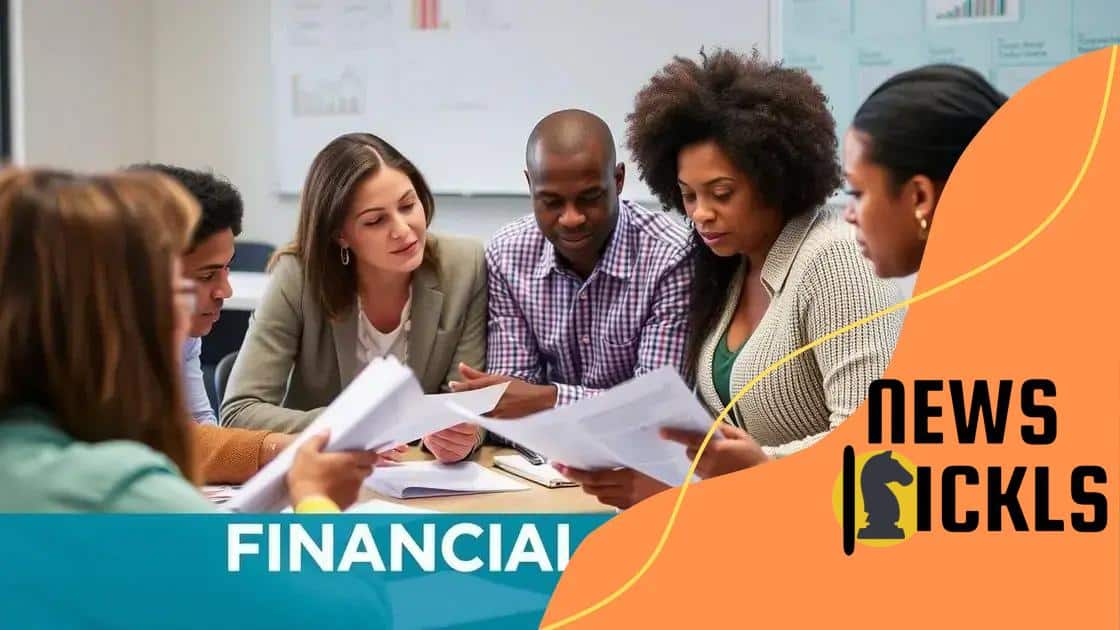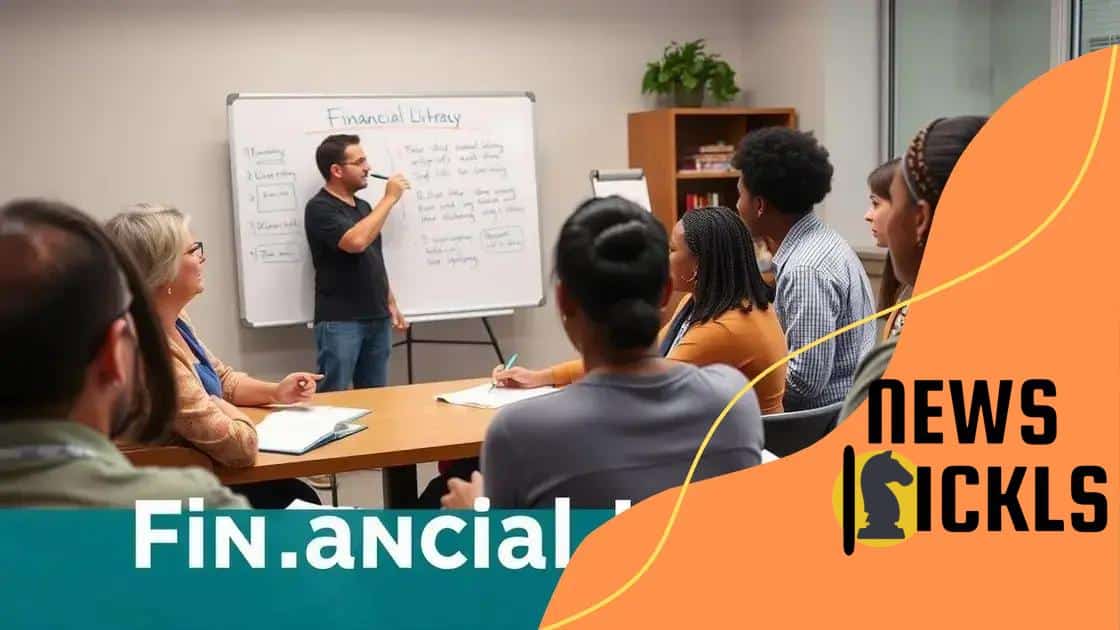The role of financial literacy in federal assistance programs

The role of financial literacy in federal assistance programs is crucial as it empowers individuals to effectively manage their finances and maximize the benefits of available resources.
The role of financial literacy in federal assistance programs can greatly influence the success of beneficiaries. Have you ever wondered how understanding financial concepts can change your experience with these programs?
Understanding financial literacy
To truly grasp the importance of financial literacy, one must understand its foundation. Financial literacy involves the ability to make informed decisions about managing money. It encompasses various topics, including budgeting, saving, investing, and understanding credit. A solid grounding in these areas not only empowers individuals but also enhances their capacity to navigate federal assistance programs more effectively.
Key Components of Financial Literacy
Understanding the core elements of financial literacy is crucial. Here are some key components that everyone should know:
- Budgeting: Creating and sticking to a budget helps individuals track their income and expenses.
- Saving: Knowing how to save effectively ensures that there are funds available for emergencies.
- Investing: Understanding investment options can help grow wealth over time.
- Credit Management: Being aware of how credit works helps in maintaining a good credit score.
Many individuals struggle with these concepts. For example, those unfamiliar with budgeting may overspend and find themselves in debt. This confusion can lead people to miss out on federal assistance programs that could help them. It’s essential to close this knowledge gap to gain the maximum benefits available.
Financial Literacy and Its Impact
The relationship between financial literacy and federal assistance is significant. When people are financially literate, they can use assistance programs more effectively. They can identify which resources are best for their situations and how to apply them wisely. With programs like SNAP or housing assistance, understanding the requirements and benefits is key to making the most of them.
Moreover, financial literacy can foster long-term stability. By learning these skills, individuals can develop a plan for their future. They may move from dependence on assistance to self-sufficiency. The journey of improving one’s financial literacy requires commitment and resources, which can be found in community programs and online courses.
In conclusion, building financial literacy is a vital step towards utilizing federal assistance programs effectively. Recognizing the value of managing one’s finances opens doors to better opportunities for individuals and families alike.
Impact of financial literacy on federal assistance
The impact of financial literacy on federal assistance is profound. When individuals understand financial concepts, they can navigate assistance programs more effectively. This knowledge allows them to access resources designed to help, leading to better outcomes.
Enhancing Program Utilization
Financial literacy plays a key role in how well recipients utilize federal programs. Those who are financially literate often:
- Identify appropriate programs: They can match their needs with available resources.
- Understand eligibility requirements: Knowing the criteria helps in applying correctly.
- Maximize benefits: Financially savvy individuals are more likely to get the most out of assistance.
For instance, a person familiar with budgeting is likely to allocate their benefits more effectively, ensuring they last throughout the month. This can be crucial for programs like Supplemental Nutrition Assistance Program (SNAP), where managing limited resources is essential.
Improving Financial Decision-Making
Another significant outcome of being financially literate is improved decision-making. When individuals possess this knowledge, they tend to:
- Avoid costly mistakes: Financial literacy helps prevent choices that could lead to debt.
- Seek additional resources: Literate individuals are more inclined to look for programs offering financial coaching or education.
- Plan for the future: They can set goals and create savings plans to secure their financial well-being.
This empowers recipients to transition from reliance on federal assistance to greater financial independence. A strong foundation in financial knowledge can set them on a path towards self-sufficiency, not just in the short term, but as a lifelong skill.
Ultimately, enhancing financial literacy among individuals can lead to reduced dependence on federal assistance programs. As they gain skills and confidence, they can achieve greater stability in their lives.
Tools to improve financial literacy

To enhance financial literacy, various tools can be utilized. These resources empower individuals to manage their finances better and make informed decisions. Whether online or through community programs, there are many options available.
Online Resources
Using the internet can be a great way to access financial education. Several websites and platforms provide free courses and tools. Here are some notable resources:
- Personal finance websites: Sites like Smart About Money offer free advice and budgeting tools.
- Webinars: Many organizations host online seminars on financial topics.
- Mobile apps: Apps like Mint help users track their spending and create budgets.
Accessing these tools can provide step-by-step guidance on managing money. Users can learn about saving, investing, and credit management in a structured manner.
Community Workshops
Besides online options, community programs also play a crucial role in improving financial literacy. Local organizations and libraries often offer workshops. These sessions typically cover a range of topics, such as:
- Budgeting basics: Workshops teach how to create and stick to a budget.
- Debt management: Classes discuss strategies to reduce and manage debt effectively.
- Understanding credit: Programs explain credit scores and how to improve them.
These interactive sessions provide an opportunity for individuals to ask questions and engage with instructors. Participants can gain confidence in handling their finances and applying what they learned to real-world situations.
Finally, combining online resources with local workshops offers a comprehensive approach to achieving financial literacy. Using these tools can pave the way for better decision-making and financial independence.
Challenges in financial literacy education
There are several challenges in financial literacy education that need addressing. While many programs aim to improve financial knowledge, barriers often hinder their success. Understanding these hurdles is the first step towards overcoming them.
Lack of Access to Resources
One significant challenge is the lack of access to educational resources. Many individuals, especially in low-income areas, may not have:
- Access to internet: Without reliable internet, online courses and resources become unavailable.
- Local workshops: Some regions lack community programs that provide financial education.
- Financial advisors: People may not have the opportunity to meet with professionals who can guide their learning.
This limited access prevents individuals from gaining the knowledge necessary to make informed financial decisions.
Different Learning Styles
Another challenge is that individuals learn in various ways. Some people grasp concepts better through:
- Hands-on experience: Learning by doing can be more effective than just reading materials.
- Visual aids: Charts and infographics help those who learn visually.
- Interactive sessions: Group discussions and workshops can engage learners who benefit from interaction.
Programs that do not accommodate these different learning styles may fail to reach their target audience effectively. Tailoring financial literacy education to different needs is essential.
Furthermore, fear and embarrassment can also hold people back. Many individuals may feel ashamed of their financial situations and avoid seeking help. This prevents them from participating in programs designed to improve their knowledge. Building a supportive environment is vital for encouraging participation.
Finally, without proper evaluation, it is challenging to measure the success of financial literacy programs. Organizations need to assess their impact regularly. Gathering feedback can provide insights into what works and what needs improvement. Addressing these challenges can lead to more effective financial literacy education.
Future directions for assistance programs
The future directions for assistance programs will likely focus on inclusivity and efficiency. As society evolves, these programs must adapt to meet the changing needs of individuals and families. Ensuring that everyone can access resources and support is essential for long-term success.
Enhanced Accessibility
One primary goal will be to enhance accessibility. Making assistance programs easier to navigate can help more people receive support. Future developments may include:
- Online applications: Simplifying the process through digital platforms can reduce barriers.
- Multilingual resources: Offering materials in various languages ensures that non-English speakers can access help.
- Mobile access: Creating mobile-friendly applications will allow users to apply and manage their needs on the go.
This focus on accessibility is crucial for reaching diverse populations and making sure everyone knows what assistance is available.
Integration of Technology
Additionally, integrating technology into assistance programs is likely to be a key trend. Technology can streamline processes and enhance efficiency. For example, utilizing:
- Data analytics: Programs can analyze data to identify trends and target populations more effectively.
- Artificial intelligence: AI can help personalize assistance recommendations based on individual needs.
- Online education tools: These resources can help recipients improve their skills, boosting financial literacy.
With these advancements, assistance programs can better serve their communities and respond to specific needs more quickly.
Furthermore, building partnerships with community organizations will strengthen support networks. By collaborating with local groups, assistance programs can reach those who might not otherwise seek help. These partnerships can create a holistic approach to addressing financial challenges faced by individuals.
Ultimately, the future of assistance programs involves a commitment to evolving and improving. By focusing on accessibility, technology, and partnerships, these programs can become more effective in helping individuals achieve financial stability and success in their lives.
FAQ – Frequently Asked Questions about Financial Literacy and Federal Assistance Programs
What is financial literacy and why is it important?
Financial literacy refers to the knowledge and skills needed to manage personal finances. It is important because it empowers individuals to make informed decisions about budgeting, saving, and using federal assistance effectively.
How can technology improve financial literacy education?
Technology can enhance financial literacy education by offering online resources, interactive tools, and mobile applications that make learning accessible and engaging.
What are some common challenges people face in gaining financial literacy?
Common challenges include lack of access to resources, different learning styles, fear of discussing finances, and insufficient community programs.
How can community organizations support financial literacy initiatives?
Community organizations can support financial literacy by providing workshops, resources, and personalized assistance, making education more approachable and effective for individuals.






